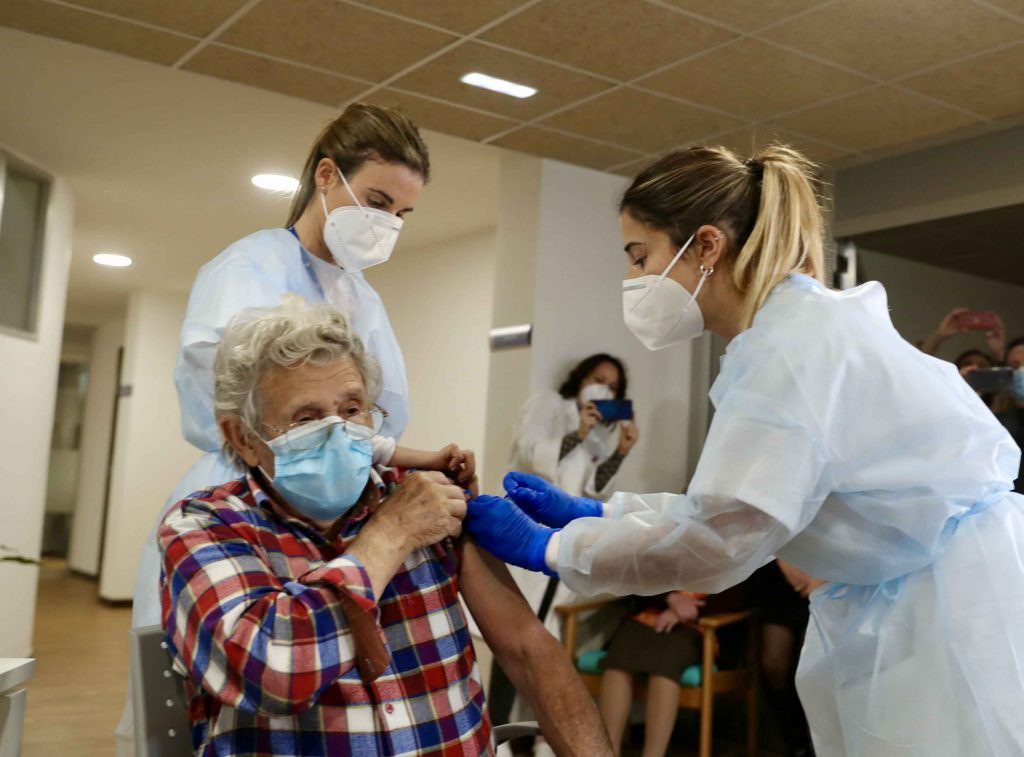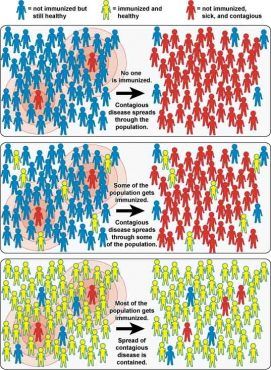Can vaccinated people transmit COVID-19? The answer will be key to ending the pandemic
By Eileen Choffnes | March 9, 2021
 A woman in Spain receives a COVID-19 vaccine. Credit: Administracion del Principado de Asturias. CC BY-SA 4.0.
A woman in Spain receives a COVID-19 vaccine. Credit: Administracion del Principado de Asturias. CC BY-SA 4.0.
In the past year, the SARS-CoV-2 (COVID-19) virus has killed more people in the United States than the number of Americans who died in World War I, World War II, and the Vietnam War combined. And, while the number of cases and deaths appears to be declining, that trend could easily reverse. What is unquestionable is that many more people need to become immune to the virus in order to extinguish this pandemic through vaccine-induced herd immunity.
While still facing issues of efficiency and equitable distribution, the US vaccine rollout is finally getting shots into people’s arms. According to the latest information from the Centers for Disease Control and Prevention, 9.4 percent of the US population has received two doses of either the Moderna or Pfizer/BioNTech mRNA vaccines. These vaccines, as well as one produced by Johnson & Johnson that was authorized for emergency use late last month, can prevent many cases of symptomatic COVID-19 infection, serious disease, hospitalizations, and death. The jury is still out, however, on another important question: How well do they do in preventing people from getting infected with COVID-19 or spreading the disease? Knowing the answer to this question is key to implementing polices to bring an end to the pandemic.
There’s been positive news about how effective the vaccines might be in preventing transmission—but as several experts note, some studies that have been made public so far are inconclusive. Until we have a better answer on transmission, social distancing, hand hygiene, testing, and mask wearing will remain important in the fight to limit and eventually end the pandemic.
A recent, unpublished Israeli study showed a nearly 90 percent reduction in infections among the vaccinated population. Wired magazine writer Megan Molteni noted that the media framing of the study may have been overly optimistic. While the headlines about this unpublished study were wildly enthusiastic, the reality is more nuanced. “Israel finds BioNTech/Pfizer vaccine reduced virus transmission,” read one headline. But Eric Topol, a professor of molecular medicine at Scripps Research, told Wired he was skeptical about drawing any conclusions about the extent to which the Pfizer vaccine cut transmission rates. He told the magazine that to accurately study asymptomatic transmission, both vaccinated and unvaccinated people should be regularly tested. “The testing rates were such a hodgepodge, I don’t know you can make any conclusions about how much the vaccine cut transmission in Israel, let alone assigning a number as concrete as 89.4 percent,” he told Molteni.
The way vaccines work is by tricking the body’s immune system into believing it has been exposed to a “foreign” invader so that it initiates a series of responses, namely producing antibodies and memory cells, like it would against viruses or other pathogens. Should someone encounter the same disease in real life her immune system would be “primed” to neutralize or kill the foreign invader. This is what makes vaccines such powerful medical weapons against diseases. And, in an ideal world, this is the way a vaccine is supposed to work—to prevent infection by immunizing the entire at-risk population creating both individual and population herd immunity, the kind of wide-spread immunity that prevents a pathogen from infecting susceptible hosts.
In the 20th Century the goal of mass vaccination campaigns was to induce herd immunity and prevent or eliminate the sickness and death associated with an infectious pathogen. The scientist A.W. Hedrich described herd immunity almost a century ago in children naturally infected with measles. He noticed that measles outbreaks in Baltimore occurred when most children hadn’t previously had the disease. Epidemics ended when the percentage of susceptible children in the population fell low enough. More surprising was that this immunity protection extended to children who had not been exposed to the viral disease—the conclusion being that immune individuals were unlikely to contribute to disease transmission.
According to the Centers for Disease Control and Prevention, herd or community immunity occurs when a high enough percentage of the population is immune to an infectious disease either through vaccination or previous illness that the disease is unlikely to spread person-to-person. Even people who haven’t been vaccinated like newborns are also protected in this scenario. The herd immunity threshold is not set in stone, however. David Morens, a senior advisor to National Institute of Allergy and Infectious Diseases director Anthony Fauci, told The New York Times that the studies that accurately measured herd immunity were observations of how fast a contagious disease spread among penned animals. Studying how a disease spreads among people is difficult, because people move around locally, regionally, and globally. Depending on how well the vaccines cut transmission of COVID-19, the herd immunity threshold could rise or fall.

If the currently available vaccines are injected into arms fast enough on an international scale and confer herd immunity to COVID-19, what will it take to finally halt the spread of this disease in the United States? Estimates suggest that at the current pace 70 percent of the US population will be at least partially vaccinated by mid-September 2021. Researchers say between 70 to 90 percent of the population will need to get vaccinated before the country reaches herd immunity. How long that takes depends on a variety of factors including the herd immunity threshold, vaccine supply, and pace of vaccination. More contagious and virulent coronavirus variants that are resistant to vaccines, as well as vaccine hesitancy, could also complicate the path to herd immunity.
A recent article in the New York Times presented three scenarios for the United States to achieve vaccine-induced herd immunity for COVID-19. The first scenario suggests that at our current pace of injecting 1.7 million shots per day, we could theoretically reach herd immunity by July 2021 with an additional 100,000 deaths. If the vaccination rate were to double to approximately 3 million shots per day, we could reach herd immunity by May 2021, with 90,000 additional deaths. By tripling the pace of vaccination to 5 million shots per day, the United States could achieve herd immunity by April of this year with 80,000 additional deaths. In other words, the more people that get vaccinated, the faster the United States could reach the threshold for herd immunity.
In addition to the question of how well the vaccines prevent COVID-19 from spreading, experts are unsure about whether the current crop of vaccines will continue to be effective against new strains of the virus. The United States does not conduct active genomic surveillance for COVID-19, and public health researchers are discovering these virus strains after they have become established and begun to spread within the community. While some companies are preparing for the possibility of producing new vaccines for the variants—developing new shots against the strain first identified South Africa, for instance—creating a new vaccine every time a new strain of the virus evolves is like playing a high-tech game of “whack-a-mole.” And regrettably, in this particular game, if people stop wearing masks, using other physical control measures, and behaving as if the virus is no longer the threat that it is, the virus will continue winning.
So what exactly are people who’ve received the vaccine able to do now that they weren’t able to do before? As Rachel Gutman wrote recently in The Atlantic, there is one guiding principle that could help the vaccinated and the unvaccinated navigate this brave new world: “When deciding what you can and can’t do, you should think less about your own vaccination status and more about whether your neighbors, family, grocery clerks, delivery drivers, and friends are themselves still vulnerable to the virus.” If they are and if virus cases are increasing in someone’s area then all the mask wearing, social distancing, and hand hygiene practices employed prior to vaccination need to continue post-vaccination. The Centers for Disease Control and Prevention, meanwhile, issued new guidance on Monday that vaccinated people could meet inside without masks and also meet unmasked with low-risk people from another household.
Amid the uncertainty over the trajectory of the pandemic, public health officials are still urging caution. Fauci warned Sunday on Face the Nation that Americans shouldn’t get complacent about following mitigation measures to combat the spread of the coronavirus, even though the number of new cases is leveling off and more Americans are getting a shot(s) in the arm. He stressed that “Americans should continue to comply with public health measures such as wearing masks, avoiding large gatherings, and social distancing.” Despite Fauci and other federal government officials urging continued vigilance, the governors of Texas and Mississippi have issued executive orders lifting their states’ mask mandates and letting all businesses reopen at full capacity.
President Joe Biden criticized the Republican governors, calling their decisions to end state-wide mask mandates “a big mistake.” He said the country was on the “cusp of being able to fundamentally change the nature of this disease” with the distribution of vaccines. “The last thing we need is Neanderthal thinking that in the meantime, everything’s fine.”
Until we know how well the current vaccines protect against infection and transmission or until a new vaccine platform is developed that will block the transmission of COVID-19, the old standbys of social distancing, hand hygiene, molecular testing of symptomatic and more importantly asymptomatic individuals, and mask wearing will go along way toward stopping viral transmission and slowing the evolution of this virus. These practices, and more, have been and continue to be successfully applied in countries like Australia and New Zealand to bring their COVID-19 case numbers down to near zero. The United States can do this as well; dramatically reducing US case numbers just requires the will to do it.
Together, we make the world safer.
The Bulletin elevates expert voices above the noise. But as an independent nonprofit organization, our operations depend on the support of readers like you. Help us continue to deliver quality journalism that holds leaders accountable. Your support of our work at any level is important. In return, we promise our coverage will be understandable, influential, vigilant, solution-oriented, and fair-minded. Together we can make a difference.
Keywords: Coronavirus, herd immunity, vaccines
Topics: Opinion















